Humanities/Arts Exam > Humanities/Arts Notes > Geography Class 11 > Revision Notes - Solar Radiation, Heat Balance and Temperature
Solar Radiation, Heat Balance and Temperature Class 11 Geography
| Table of contents |

|
| Solar Radiation |

|
| Heating and Cooling of Atmosphere |

|
| Heat Budget of the Planet Earth |

|
| Temperature |

|
Solar Radiation

- The earth’s surface receives most of its energy in short wavelengths. The energy received by the earth is known as incoming solar radiation which in short is termed as insolation.
- As the earth is a geoid resembling a sphere, the sun’s rays fall obliquely at the top of the atmosphere and the earth intercepts a very small portion of the sun’s energy. On an average the earth receives 1.94 calories per sq. cm per minute at the top of its atmosphere.
- During its revolution around the sun, the earth is farthest from the sun (152 million km) on 4th July. This position of the earth is called aphelion.
- On 3rd January, the earth is the nearest to the sun (147 million km). This position is called perihelion.
- Therefore, the annual insolation received by the earth on 3rd January is slightly more than the amount received on 4th July.
- Variation in the solar output does not have great effect on daily weather changes on the surface of the earth.
Question for Revision Notes - Solar Radiation, Heat Balance and TemperatureTry yourself:Higher latitudes are not permanently frozen because of
View Solution
Variability of Insolation at the Surface of the Earth
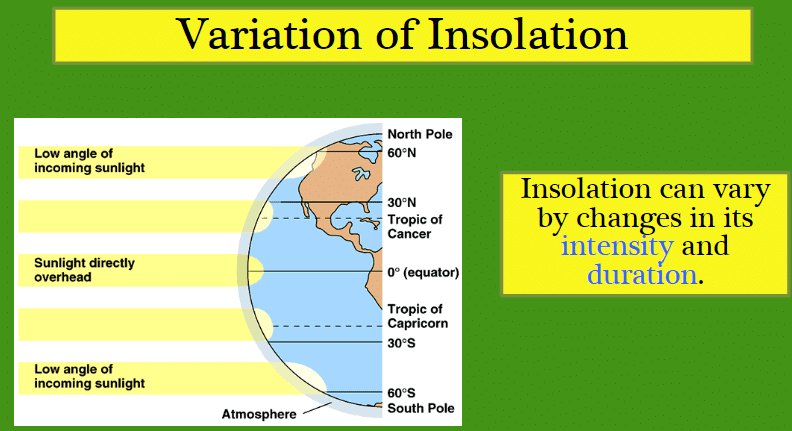
- The amount and the intensity of insolation vary during a day, in a season and in a year.
- The factors that cause these variations in insolation are:
(i) the rotation of earth on its axis;
(ii) the angle of inclination of the sun’s rays;
(iii) the length of the day;
(iv) the transparency of the atmosphere;
(v) the configuration of land in terms of its aspect.
The last two however, have less influence.(important) - The fact that the earth’s axis makes an angle of 66 with the plane of its orbit round the sun has a greater influence on the amount of insolation received at different latitudes. Note the variations in the duration of the day at different latitudes .
- The second factor that determines the amount of insolation received is the angle of inclination of the rays. This depends on the latitude of a place. The higher the latitude the less is the angle they make with the surface of the earth resulting in slant sun rays.
The Passage of Solar Radiation through the Atmosphere
- The atmosphere is largely transparent to short wave solar radiation. The incoming solar radiation passes through the atmosphere before striking the earth’s surface.
- Within the troposphere water vapour, ozone and other gases absorb much of the near infrared radiation.
- Very small-suspended particles in the troposphere scatter visible spectrum both to the space and towards the earth surface. This process adds colour to the sky.
- The red colour of the rising and the setting sun and the blue colour of the sky are the result of scattering of light within the atmosphere.
Spatial Distribution of Insolation at the Earth’s Surface
- The insolation received at the surface varies from about 320 Watt/m2 in the tropics to about 70 Watt/m2 in the poles.
- Maximum insolation is received over the subtropical deserts, where the cloudiness is the least.
- Equator receives comparatively less insolation than the tropics. Generally, at the same latitude the insolation is more over the continent than over the oceans. In winter, the middle and higher latitudes receive less radiation than in summer.
Heating and Cooling of Atmosphere
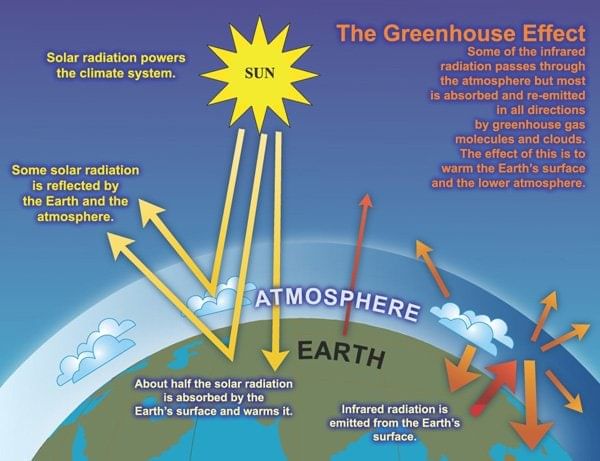
- There are different ways of heating and cooling of the atmosphere
(i) Convection
(ii) Radiation
(iii) Advection
(iv) Conduction - The air in contact with the land gets heated slowly and the upper layers in contact with the lower layers also get heated. This process is called conduction. Conduction takes place when two bodies of unequal temperature are in contact with one another, there is a flow of energy from the warmer to cooler body.
- Conduction is important in heating the lower layers of the atmosphere.
- The air in contact with the earth rises vertically on heating in the form of currents and further transmits the heat of the atmosphere. This process of vertical heating of the atmosphere is known as convection.
- Horizontal movement of the air is relatively more important than the vertical movement.
- In tropical regions particularly in northern India during summer season local winds called ‘loo’ is the outcome of advection process.
- In middle latitudes, most of diurnal (day and night) variation in daily weather are caused by advection alone.
Question for Revision Notes - Solar Radiation, Heat Balance and TemperatureTry yourself:In which one of the following cities, are the days the longest in Summar?
View Solution
Terrestrial Radiation
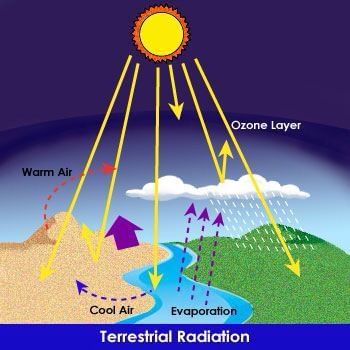
- The insolation received by the earth is in short waves forms and heats up its surface. The earth after being heated itself becomes a radiating body and it radiates energy to the atmosphere in long wave form.
- This energy heats up the atmosphere from below. This process is known as terrestrial radiation.
- The long wave radiation is absorbed by the atmospheric gases particularly by carbon dioxide and the other green house gases. Thus, the atmosphere is indirectly heated by the earth’s radiation.
- The atmosphere in turn radiates and transmits heat to the space. Finally the amount of heat received from the sun is returned to space, thereby maintaining constant temperature at the earth’s surface and in the atmosphere.
Heat Budget of the Planet Earth
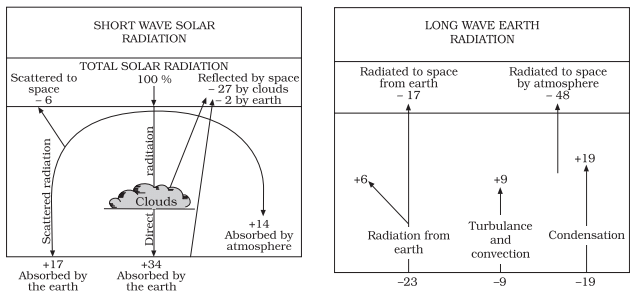
- Above figure depicts the heat budget of the planet earth. The earth as a whole does Not accumulate or loose heat. It maintains its temperature.
- This can happen only if the amount of heat received in the form of insolation equals the amount lost by the earth through terrestrial radiation.
- Consider that the insolation received at the top of the atmosphere is 100 percent.
- While passing through the atmosphere some amount of energy is reflected, scattered and absorbed.
- Only the remaining part reaches the earth surface.
- Roughly 35 units are reflected back to space even before reaching the earth’s surface.
- Of these, 27 units are reflected back from the top of the clouds.
- Only 2 units from the snow and ice-covered areas of the earth.
- The remaining 65 units are absorbed. 14 units within the atmosphere and 51 units by the earth’s surface.
Variation in the Net Heat Budget at the Earth’s Surface
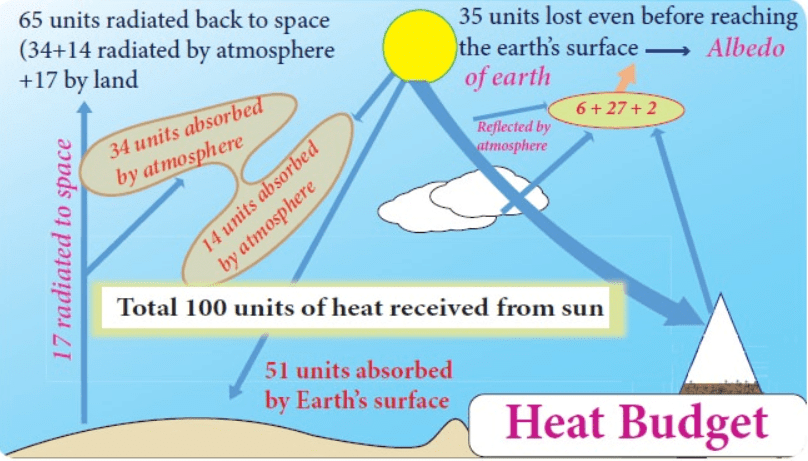
- There are variations in the amount of radiation received at the earth’s surface. Some part of the earth has surplus radiation balance while the other part has deficit.
- The surplus heat energy from the tropics is redistributed pole wards and as a result the tropics do not get progressively heated up due to the accumulation of excess heat or the high latitudes get permanently frozen due to excess deficit.
Temperature
- The interaction of insolation with the atmosphere and the earth’s surface creates heat which is measured in terms of temperature.
- While heat represents the molecular movement of particles comprising a substance, the temperature is the measurement in degrees of how hot (or cold) a thing (or a place) is.
Factors Controlling Temperature Distribution (important )
The temperature of air at any place is influenced by
- the latitude of the place;
- the altitude of the place;
- distance from the sea, the air- mass circulation;
- the presence of warm and cold ocean currents;
- local aspects.
- The latitude : The temperature of a place depends on the insolation received. It has been explained earlier that the insolation varies according to the latitude hence the temperature also varies accordingly.
- The altitude : The atmosphere is indirectly heated by terrestrial radiation from below. Therefore, the places near the sea-level record higher temperature than the places situated at higher elevations. In other words, the temperature generally decreases with increasing height. The rate of decrease of temperature with height is termed as the normal lapse rate. It is 6.5°C per 1,000 m.
- Distance from the sea: Another factor that influences the temperature is the location of a place with respect to the sea. Compared to land, the sea gets heated slowly and loses heat slowly. Land heats up and cools down quickly. Therefore, the variation in temperature over the sea is less compared to land. The places situated near the sea come under the moderating influence of the sea and land breezes which moderate the temperature.
- Air-mass and Ocean currents : Like the land and sea breezes, the passage of air masses also affects the temperature. The places, which come under the influence of warm air-masses experience higher temperature and the places that come under the influence of cold air- masses experience low temperature. Similarly, the places located on the coast where the warm ocean currents flow record higher temperature than the places located on the coast where the cold currents flow.
Distribution of Temperature

- The global distribution of temperature can well be understood by studying the temperature distribution in January and July.
- The Isotherms are lines joining places having equal temperature.
- Northern hemisphere the land surface area is much larger than in the southern hemisphere. Hence, the effects of land mass and the ocean currents are well pronounced.
- In January the isotherms deviate to the north over the ocean and to the south over the continent. This can be seen on the North Atlantic Ocean. The presence of warm ocean currents, Gulf Stream and North Atlantic drift, make the Northern Atlantic Ocean warmer and the isotherms bend towards the north. Over the land the temperature decreases sharply and the isotherms bend towards south in Europe.
- It is much pronounced in the Siberian plain. The mean January temperature along 60° E longitude is minus 20° C both at 80° N and 50° N latitudes.
- The mean monthly temperature for January is over 27° C, in equatorial oceans over 24° C in the tropics and 2° C - 0° C in the middle latitudes and –18° C to – 48° C in the Eurasian continental interior.
- The effect of the ocean is well pronounced in the southern hemisphere. Here the isotherms are more or less parallel to the latitudes and the variation in temperature is more gradual than in the northern hemisphere. The isotherm of 20° C, 10° C, and 0° C runs parallel to 35° S, 45° S and 60° S latitudes respectively.
- In July the isotherms generally run parallel to the latitude. The equatorial oceans record warmer temperature, more than 27°C. Over the land more than 30°C is noticed in the subtropical continental region of Asia, along the 30° N latitude. Along the 40° N runs the isotherm of 10° C and along the 40° S the temperature is 10° C.
Inversion of Temperature
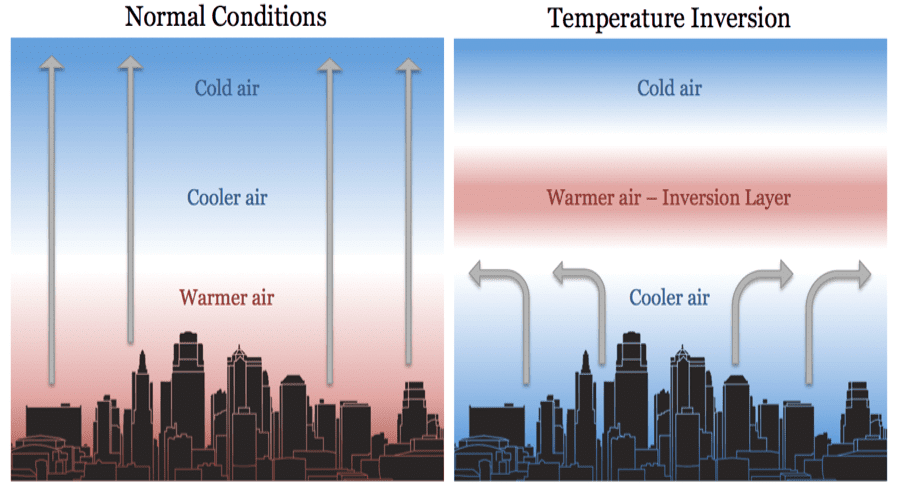
- Normally, temperature decreases with increase in elevation. It is called normal lapse rate. At times, the situations is reversed and the normal lapse rate is inverted. It is called Inversion of temperature.
- Inversion is usually of short duration but quite common nonetheless. A long winter night with clear skies and still air is ideal situation for inversion.
- The heat of the day is radiated off during the night, and by early morning hours, the earth is cooler than the air above.
- Over polar areas, temperature inversion is normal throughout the year. The inversion takes place in hills and mountains due to air drainage. Cold air at the hills and mountains, produced during night, flows under the influence of gravity.
Question for Revision Notes - Solar Radiation, Heat Balance and TemperatureTry yourself:The sun is vertically over head at noon on 21st June at
View Solution
The document Solar Radiation, Heat Balance and Temperature Class 11 Geography is a part of the Humanities/Arts Course Geography Class 11.
All you need of Humanities/Arts at this link: Humanities/Arts
|
70 videos|340 docs|53 tests
|
FAQs on Solar Radiation, Heat Balance and Temperature Class 11 Geography
| 1. How does solar radiation impact the heating and cooling of the Earth's atmosphere? |  |
Ans. Solar radiation is the primary source of energy for the Earth, and it plays a crucial role in heating the atmosphere. When solar radiation reaches the Earth, some of it is absorbed by the surface, leading to the warming of the atmosphere. This absorption of solar radiation is essential for maintaining the temperature balance on the planet.
| 2. What factors contribute to the heat budget of the Earth? |  |
Ans. The heat budget of the Earth is determined by the balance between incoming solar radiation and outgoing thermal radiation. Factors such as the Earth's albedo, greenhouse gases, clouds, and atmospheric circulation all play a role in regulating the heat budget of the planet.
| 3. How does the Earth's temperature remain relatively stable despite changes in solar radiation? |  |
Ans. The Earth's temperature remains relatively stable due to the planet's heat budget, which involves a balance between incoming solar radiation and outgoing thermal radiation. This balance is maintained through various mechanisms such as the greenhouse effect, which traps heat in the atmosphere, and feedback loops that help regulate temperature fluctuations.
| 4. What is the role of greenhouse gases in the Earth's temperature regulation? |  |
Ans. Greenhouse gases such as carbon dioxide and methane play a crucial role in regulating the Earth's temperature. These gases trap heat in the atmosphere, preventing it from escaping into space. Without greenhouse gases, the Earth would be much colder, making it uninhabitable for most forms of life.
| 5. How does the Earth's atmosphere help distribute heat around the planet? |  |
Ans. The Earth's atmosphere helps distribute heat around the planet through processes such as convection, conduction, and radiation. These mechanisms transfer heat from regions of higher temperature to regions of lower temperature, helping to maintain a relatively stable climate on Earth.
Related Searches
















